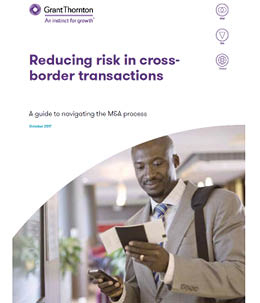-
Transactional advisory services
Find out more about the transactional advisory services of Grant Thornton Financial Advisory Services
-
Valuations
Find out more about the valuations services of Grant Thornton Financial Advisory Services
-
Mergers and acquisitions
Find out more about the merger and acquisition services of Grant Thornton Financial Advisory Services
-
Forensic and investigation services
Find out more about the forensic and investigation services of Grant Thornton Financial Advisory Services
-
Recovery & reorganisation
Find out more about the Recovery & reorganisation services of Grant Thornton Financial Advisory Services
-
Business risk services
Find out more about the business risk services of Grant Thornton Financial Advisory Services
-
Business consulting
Find out more about the business consulting services of Grant Thornton Financial Advisory Services
-
Capital market
Capital market
-
Corporate and business tax
Find out more about our corporate and business tax services.
-
Direct international tax
Find out more about our direct international tax services.
-
Global mobility services
Find out more about our global mobility services.
-
Indirect international tax
Find out more about our indirect international tax services.
-
Transfer pricing
Find out more about our transfer pricing services.
-
Litigation
Our lawyers and accountants can manage all defense measures provided not only by the Italian law, but also by EU regulations and conventions
-
Family business
Find out more about our Family business services.
-
Legal
The client can be assisted in every need and with the same care both on important operations or disputes and on simple matters

-
Back office outsourcing
Find out more about our Back office outsourcing services
-
Business process outsourcing
Find out more about our business process outsourcing services.
-
Compilation of financial statements
Find out more about our compilation of financial statements services.
-
Tax compliance
Find out more about our tax compliance services.
-
Electronic invoicing
Find out more about our electronic invoicing services
-
Electronic storage
Electronic storage is an archiving procedure that guarantees the legal validity of a digitally stored electronic document
-
Revaluation of corporate assets
Find out your civil and fiscal revaluation of tangible, intangible and financial assets
-
Human resources consulting
Find out more about our human resources consulting services.
-
Payroll
Find out more about our payroll services.
-
HR News
HR News the monthly information newsletter by Grant Thornton HR
-
Cybersecurity
GT Digital helps clients structure information security management internal functions, also through partially or totally outsourced functions
-
Agile and Programme Management
GT Digital provides support in the adoption and implementation of different portfolio management
-
Robotic Process Automation
Our “BOT Farm” can rely on digital workers able to help clients in routine activities, allowing employees to deal with more added-value activities
-
Data strategy and management
GT Digital can support clients in seizing the opportunities offered by Big Data, from the definition of strategies to the implementation of systems
-
Enterprise Resource Planning
We support clients in selecting the most appropriate ERP System according to their specific needs, helping them also understand licensing models
-
IT strategy
GT Digital supports clients in making strategic choices, identifying innovation opportunities, comparing themselves with competitors
-
IT service management
We can support with software selection and with the implementation of dedicated tools for the management of ICT processes
-
DORA and NIS 2
The entry into force of the DORA Regulation and NIS2 represents a major step towards the creation of a harmonised regulatory framework
A guide to navigating the M&A process
Cross-border merger and acquisition opportunities are increasing, as healthy company financials in many economies drive an appetite for deals. Grant Thornton’s International Business Report (IBR) shows that companies within Africa and the Middle East have the most appetite for transactions over the next three years, followed by North America and the EU.
However, while cross-border transactions can generate new market opportunities, they often bring heightened risk and a range of challenges. Deals can be hindered by many hurdles anywhere in the process.
To successfully navigate your transaction landscape, it’s important to understand and prevent potential risks. You also need to know how to smooth the integration process after completion of the deal.We asked over 2,000 decision makers of mid-sized businesses to share the most significant risks encountered before and after a transaction. Mapping these challenges across the deal lifecycle, we added best practice guidance to mitigate these hazards. Our aim is to provide a guide that will enhance the success of your cross-border transaction, across any industry or region.
Stefano Salvadeo, Co-managing partner and Head of Growth and Advisory Services at Bernoni Grant Thornton, stated:
"Cross border M&A operations have always been a viability indicator of national economies. Economies that carry out cross border transactions and induce their companies to acquire international entities are considered healthy economies able to improve their role in the international context.
Italy, on the contrary, is seen more as a prey rather than as a predator, which is demonstrated, for example, from the fact that many Italian prestigious entities are owned by foreign holders. This is also due to the fragmentation of the Italian economy in small and medium enterprises and to the lack of national giants.
In fact, Italians have introduced the concept of “multinazionali tascabili” (pocket multinationals) to describe Italian middle companies that are leaders in their respective industries and that are able to develop internationally also through M&A operations in other markets.
As all transactions, every single M&A operation has specific characteristics that must be duly managed in order to prevent them from becoming hindrances to the success of the operation itself.
Typically, the most critical elements consist in contractual aspects, legislative restrictions, valorisation of the company involved in the operation, seller’s liability, support to strategic customers and/or suppliers, loss of key people. Then, when the transaction is concluded, the so-called post deal integration can determine the success - or the failure - of the operation.
Integrating the acquired company efficiently and effectively and obtaining management saving and scale economies, thus reaching a better market coverage, makes the operation successful. Otherwise, the operation would remain just a formal agreement or, worse, be a failure and lead to the failure of the involved entities.
In a cross border transaction, critical elements increase significantly, both in number and in importance. Therefore, the pre-acquisition due diligence activity is crucial. Besides the traditional (financial, business, tax and legal) due diligence activities it is also important, especially today, to invest time and resources in an IT due diligence.
It is important to analyse the different information systems and understand how to integrate them: an efficient management of information systems implies the capability to make the right decisions for the business.
Besides analysing information systems (i.e. analysis of their suitability), it is also necessary to investigate cybersecurity, which is such a popular issue today but, often, the relevant principles are not very much considered.
Integrating a company without analysing its cybersecurity level, especially in industries where know how and creativity play an important role, means jeopardizing the value of the acquired company.
It is demonstrated that cyber espionage can cause serious damages and that cyber-attacks increase when the management is focussed on other things, which means that a company can most likely come under attack during the post integration phase.
Investing resources to know the state of the art and filling the gaps has certainly a cost: but this cost is insignificant compared to the damages caused by the lack of cybersecurity that protects the company against internal and external threats.
Besides legal risks relevant to exportations in other countries subject to different rules (and political-economical risks), when the investment is carried out in countries under geopolitical critical situations, there is a more serious risk to be considered, i.e. the economic culture of each country.
If different cultures are not duly understood and managed, the operation and the integration of the involved companies could be hardly performed. It is therefore necessary to plan a cross border operation carefully, focussing on the mitigation of risks, investing the right resources in the pre- and post-deal phases and rely on consultants having a vast presence in the countries involved, in order to ensure a consistent management of the transaction."
Reducing risk in cross-border transactions

